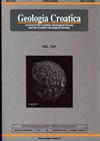The future of mining in the Adria region: current status, SWOT and Gap analysis of the mineral sector
IF 1.1
4区 地球科学
Q3 GEOLOGY
引用次数: 2
Abstract
The Adria region which includes the countries of: Albania, Bosnia and Herzegovina, Croatia, Montenegro, North Macedonia, and Serbia, and corresponds to the Dinarides, northwesternmost Hellenides, and the Vardar zone, has a long history of mining. Here, the main strengths and challenges of the mineral sector of the Adria region were assessed using the following methodology: (1) presentation of the current status of mineral exploration and exploitation, (2) SWOT (Strengths, Weaknesses, Opportunities, Threats) analysis on parameters including geological potential, economic environment, legal and regulatory framework, innovation and technology framework, environmental protection and land use planning, governmental and social potential, human resources and educational potential, (3) Gap analysis, and (4) integration of the results obtained in the development of a roadmap for the actions required to promote investments in the mineral sector in the Adria region. The main strengths of the regional mineral sector include the significant mineral potential due to a favourable geological setting, significant reserves, a long mining tradition, and active exploration areas, as well as a significant number of active and abundant mines and the availability of secondary raw materials. Nevertheless, there are many challenges that the mineral sector faces, such as difficulties in ensuring social acceptance, a lack of new exploration campaigns in many areas, estimation of resources or reserves that do not follow international codes and standards, regulations related to environmental issues in the mineral sector of Adria countries that do not comply with European legislation, and the limited availability of qualified technical, scientific and managerial personnel involved in the whole mineral cycle. Therefore, actions and measures such as awareness campaigns to highlight the significance of Raw Materials in the sustainable development of the region, further exploration, reserves calculation in alignment with internationally recognized codes, harmonization with spatial plans, and reforms to attract investors and capacity building programs should be taken for further development of the Adria region’s mineral sector in a sustainable manner.亚得里亚海地区采矿业的未来:矿产行业的现状、SWOT和差距分析
亚得里亚海地区包括以下国家:阿尔巴尼亚、波斯尼亚和黑塞哥维那、克罗地亚、黑山、北马其顿和塞尔维亚,与Dinarides、最西北的Hellenides和Vardar地区相对应,有着悠久的采矿历史。在此,使用以下方法评估了亚得里亚海地区矿产部门的主要优势和挑战:(1)介绍矿产勘探和开采的现状,(2)对地质潜力、经济环境、法律和监管框架等参数进行SWOT分析,创新和技术框架、环境保护和土地利用规划、政府和社会潜力、人力资源和教育潜力,(3)差距分析,以及(4)整合在制定促进亚得里亚海地区矿产部门投资所需行动路线图过程中获得的结果。区域矿产部门的主要优势包括有利的地质环境、巨大的储量、悠久的采矿传统和活跃的勘探区,以及大量活跃和丰富的矿山和二次原材料的可用性,具有巨大的矿产潜力。尽管如此,矿产部门仍面临许多挑战,如难以确保社会接受,许多地区缺乏新的勘探活动,对资源或储量的估计不符合国际规范和标准,与亚得里亚海国家矿产部门环境问题有关的法规不符合欧洲立法,以及参与整个矿物循环的合格技术、科学和管理人员有限。因此,采取行动和措施,如提高认识运动,强调原材料在该地区可持续发展中的重要性,进一步勘探,根据国际公认的准则计算储量,与空间计划协调一致,应采取改革以吸引投资者和能力建设计划,以可持续的方式进一步发展亚得里亚海地区的矿产部门。
本文章由计算机程序翻译,如有差异,请以英文原文为准。
求助全文
约1分钟内获得全文
求助全文
来源期刊

Geologia Croatica
GEOSCIENCES, MULTIDISCIPLINARY-
CiteScore
2.90
自引率
23.10%
发文量
35
审稿时长
>12 weeks
期刊介绍:
Geologia Croatica welcomes original scientific papers dealing with diverse aspects of geology and geological engineering, the history of the Earth, and the physical changes that the Earth has undergone or it is undergoing. The Journal covers a wide spectrum of geology disciplines (palaeontology, stratigraphy, mineralogy, sedimentology, petrology, geochemistry, structural geology, karstology, hydrogeology and engineering geology) including pedogenesis, petroleum geology and environmental geology.
Papers especially concerning the Pannonian Basin, Dinarides, the Adriatic/Mediterranean region, as well as notes and reviews interesting to a wider audience (e.g. review papers, book reviews, and notes) are welcome.
 求助内容:
求助内容: 应助结果提醒方式:
应助结果提醒方式:


